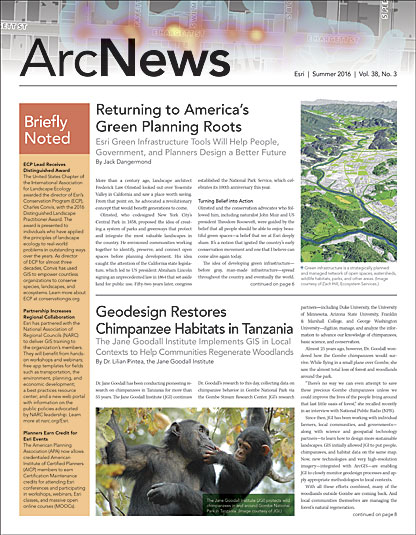Managing GIS, A column from members of the Urban and Regional Information Systems Association

To achieve true success, managers must not only manage; they must also lead.
These two concepts are different. As Warren Bennis, creator of the modern field of leadership studies, has said, “Managers are people who do things right and leaders are people who do the right thing.” When management and leadership are employed in concert, great things can happen.
I lead an incredibly talented and dedicated GIS team at Tallahassee-Leon County GIS (TLCGIS), an interlocal GIS agency formed in 1990 to serve the City of Tallahassee, the Leon County Board of County Commissioners, and the Leon County Property Appraiser’s Office. TLCGIS’s missions include promoting resource sharing, reducing redundancy in data collection and maintenance, encouraging solutions based on enterprise information management, and enhancing decision-making for public officials.
In my 17 years at TLCGIS, I have learned and practiced what makes a good manager. I have also built leadership skills that grow with each new opportunity.
Through this training and practice, what has stuck with me above all is this: managers need to manage for the best among us, not the worst. Here are some ways to do that.
Invest in Work Relationships
Many of us spend as much time—or more—with our work families as we do with our home families. So why not invest in work relationships?
A few days per week, I walk around and talk to my team members about what they are working on and what’s going on in their lives. This is an effective way to build trust and respect within a group. Getting to know my team members has enabled me to believe in them, encourage them, and give them more opportunities to advance their skills.
Recently, for example, my team gained a new member to work on large, complicated utility databases. His previous experience did not include this kind of work, so he required new skills. After discussing with him what he needed, we agreed that he would get training on data replication with Esri software and database administration for Oracle. I promptly pulled together the training, and after he completed it, he tackled the project brilliantly. From the beginning, I knew he could accomplish great things in this position, and he has exceeded expectations.
Construct a Productive Environment
Environment matters, so create one that the team can thrive in.
Workspaces can set the mood for inspiration and creativity or boredom and lackluster work. Consider meeting spaces. These areas are meant to stimulate teamwork and inventiveness. They need to be places where people want to go. There should be comfortable seating, warm lighting, and nicely painted walls.
At TLCGIS, we updated our meeting spaces the first chance we got. In addition to improving the furniture and aesthetics of each area, we made sure we had the right technology, such as a large-screen monitor and ample computing power for presentations and demonstrations. Now, we can hold daylong brainstorming sessions in our conference room and actually make progress.
Recognize a Job Well Done
When managers demonstrate that they care for their teams—by recognizing team members for their efforts, for example—employees are more willing to give 100 percent. Besides, everyone wants to be treated with respect!
When commending folks, remember that small things mean a lot. I use little tokens that say, “Great Job!” or “You Are Truly Appreciated!” When I hand one out, I include a handwritten note that recognizes the person’s specific accomplishment and why it is valued.
Once, when a TLCGIS customer was having performance issues with a complex GIS database, one team member researched the problem, sought advice, performed multiple rounds of testing, and finally found a solution. The customer was grateful, and the employee’s tenacity stood out. I recognized her achievement soon after she completed the project, and that helped her maintain confidence when the next challenge popped up (which was within that same week).
Generate Some Fanfare
TLCGIS is a very busy GIS shop. We do a lot of great things without much fanfare. That is why I like to hold a year-in-review meeting where I take the team offsite, provide breakfast, and present a slideshow (built using Esri Story Map apps) to the team and other department managers. I keep a list going all year of everyone’s accomplishments. And I ask every team member to participate by providing content for the story map, helping to assemble it, or presenting their work.
This informs the team of what everyone has been doing all year and sends the message that what each person does matters. Additionally, by inviting other managers and administrators, I ensure that we broadcast accomplishments that would otherwise go unnoticed in such a busy public sector organization.
Keep Up with Technology
I often hear people in the GIS industry say, “We are so busy putting out fires that we never get a chance to check out the latest things.” But discovering and experimenting with the latest technology is the only way to progress and get a grasp on change. That is why research and development needs to be thought of as an investment.
At TLCGIS, we carve out time to do research and development. I schedule regular sessions where team members with certain areas of interest watch videos or webinars on specific topics. I also have team members do deeper dives on issues or products that we’re interested in. That way, fewer people set aside time to do the research, and they bring their findings back to the bigger group for further discussion.
We use videos from Esri User Conferences to learn about new topics and tools that enhance our knowledge. We also use them to jump-start projects, like sharing our data on ArcGIS Open Data, which we are gearing up to do.
Staying on top of Esri software updates and releases allows us to fix issues quickly and get exposed to new features and capabilities. That makes all the difference when generating GIS solutions that work for everyone.
Communicate Clearly
For most people, communicating clearly is a lifelong challenge. But it cannot be neglected.
At TLCGIS, the organizations we support are all stakeholders in the interlocal GIS program. To minimize confusion and make sure we come up with solutions that work for each—and all—of our customers, we need to maintain open communication about our projects and tasks.
One way we communicate effectively with our city partners is by using cloud-based systems to collaborate. While these do not eliminate the need for brainstorming and planning discussions, services such as Smartsheets (which lets multiple users access smart spreadsheets and keep them updated) allow us all to easily track tasks and see the status of requests.
Face time is still important too (and, no, I’m not talking about the iPhone app). Scheduling in-person meetings with teams and customers during a project ensures that everyone is in sync. These meetings should be productive but not dull, so start with some nonwork conversation—especially if challenging topics are on the agenda.
Manage and Lead
While many of these concepts seem obvious, putting them into practice is the tough part. That is where managers become true leaders.
Think about your organization and how you can implement some of these tips. As long as you manage for the best among us, you will have the momentum your team needs to build success.
About the Author
Scott Weisman is the GIS program coordinator for Tallahassee-Leon County GIS. A 2009 graduate of URISA’s leadership academy, he holds a master’s degree in geographic information science and is a Florida certified public manager. He can be reached at weismans@leoncountyfl.gov.
Read other articles in the “Managing GIS” series.


